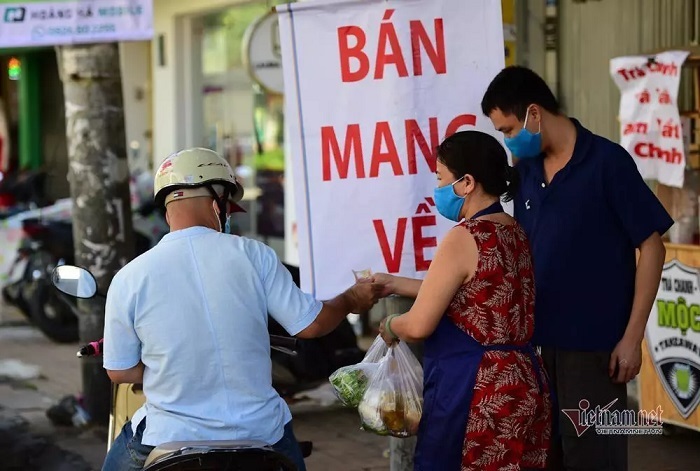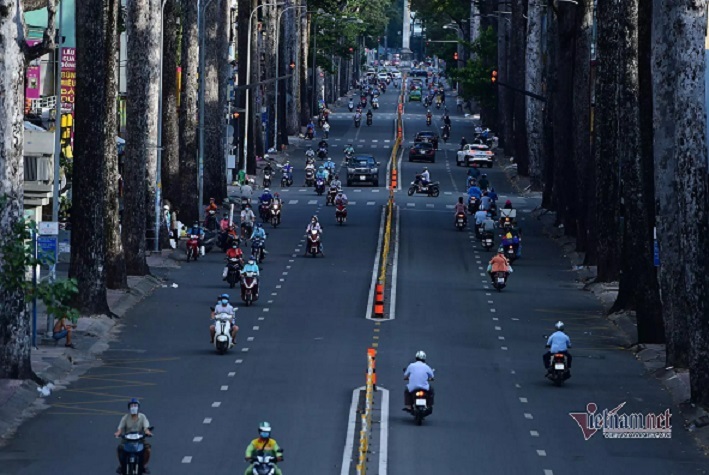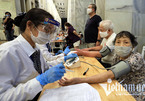The Ministry of Health’s report shows that in the past week, the number of new locally-infected cases of Covid-19 decreased compared to the previous week in some localities, for example Da Nang (down 60%), Binh Duong (27%), and Long An (3%). The average number of Covid-19 related deaths per day nationwide fell by 30%. It was 30% down for HCM City, 50% for Dong Nai, 30% for Long An, and 70% for Tien Giang.
The epidemic situation in HCM City last week also fell in two criteria: the number of cases in the community and the number of fatalities. Compared to the previous week, the rate of infection cases in the total tested cases in the whole country fell from 1.9% to 1.6%, and from 3.7% to 1.4% for HCM City.
 |
|
Ho Chi Minh City has allowed people to sell take-away food in safe areas. Photo: VietNamNet
|
In that situation, the Government issued Resolution No. 105/NQ-CP on supporting businesses, cooperatives and business households with four main groups of tasks and solutions, including:
Firstly, drastically and effectively implementing measures to prevent and control the COVID-19 epidemic, and at the same time creating favorable conditions for enterprises, cooperatives and business households to recover, maintain and develop production and business.
Secondly, ensuring stable production and circulation of goods, and dealing with supply chain disruptions.
Thirdly, providing support, cost cutting, removing financial difficulties for businesses, cooperatives and business households.
Fourthly, creating favorable conditions in terms of labor and experts.
National rehabilitation program
However, from the perspective of policy analysis, former Director of the Central Institute of Economic Management Nguyen Dinh Cung said that the program of economic recovery and economic promotion needs to be raised to the national level. The three highest decision-making bodies of the country, the Party, the National Assembly and the Government, should work together instead of the Government alone.
The national economic recovery program, Cung said, should be based on the 5-year socio-economic development strategy (2021-2026) approved by the 13th Party Congress.
“The five-year strategy needs to be changed to be suitable for a completely new situation, when the Covid-19 pandemic has left huge socio-economic impacts,” he said.
The goal of the program should identify two key issues: promoting growth and controlling disease. The program has four pillars: Restoring the economy, reopening the economy; developing infrastructure; promoting business and supporting investment; reforming business environment.
In the pillar of economic recovery, according to Cung, it is necessary to pay attention to industrial parks and enterprises that contribute in the field of exports. The policy is to accompany businesses, not to set up barriers preventing goods circulations. This roadmap will be implemented within the next six months. Besides, economic scenarios for densely populated cities and rural areas in addition to disease control should be developed.
In the pillar of infrastructure development, Cung suggested that it is necessary to improve and develop new production capacity including the development of traditional infrastructure and digital economic infrastructure.
In the pillar of business promotion and support, the first important thing is to support businesses in ensuring liquidity and capital; and encouraging enterprises to invest, create new industries, new production capacity with new economic models. In particular, investment in Ho Chi Minh City should be encouraged to promote recovery, including exemption of corporate income tax for new investment projects at a longer and more preferential level.
Meanwhile, Dr. Tran Dinh Thien emphasized the liquidity of businesses and the relationship between banks and businesses in the next few months.
He said that both banks and businesses are currently facing difficulties. It is difficult for businesses to access capital while banks are in a risky situation and cannot lower interest rates further. “In that context, liquidity is a very important, a vital issue,” he said.
According to this expert, the Government needs to consider the limits of support for banks and businesses. The government supports banks to reduce costs for businesses, and banks must ensure easier access to capital for businesses in the condition that businesses are weakened.
Recovery from an anti-epidemic perspective
 |
|
The program of economic recovery should be on a national level. Photo: VietNamNet
|
Quickly controlling the epidemic, building a recovery scenario and boosting the economy in new conditions are the concern of Prime Minister Pham Minh Chinh.
Recently, the Prime Minister assigned ministries and sectors to draw up a scenario for economic recovery based on the experiences of countries around the world.
Firstly, implementing mandatory distancing measures to slow the spread of the virus, putting localities in a position to begin reopening their economy through a variety of measures.
Next, when the economy reopens, when the capacity of the health care system is significantly increased, allowing geographies to reach a “new normal” where the capacity of the health care system is fully expanded, the spread of the virus is moderate, and localities move towards adopting measures for the readiness to return to normal.
Many groups of economic experts have proposed roadmaps to restart the economy that can be referred to in three phases:
Phase 1: Starting with businesses that have met all the necessary requirements to operate. The level of employment during this period corresponds to the proportion of employees who have got the second shot of vaccine at least two weeks prior, or the first dose for at least four weeks and are tested periodically.
Phase 2: Raising the capacity to maximum 50%. Businesses and factories can extend phase 1 longer if they want or are not ready to move to phase 2.
Phase 3: Increasing capacity up to 70% until they are allowed to operate at full capacity. For businesses and factories that are not ready, they can continue with capacity as in phase 1 or phase 2.
Enterprises can perform quick screening tests themselves (or hire a service company) for employees once a week for high-risk subjects and report the test results to local authorities.
Upon detecting infection cases, businesses will temporarily suspend operations at the line/area where the infection cases are detected, not the entire factory. The health agencies will coordinate with businesses to send infected workers to quarantine centers or hospitals.
It is a long way ahead from economic recovery to promoting economic development. People and businesses need more sharing and listening from the Government. The new approach to disease prevention will contribute to creating a corridor to protect production and circulation.
Lan Anh

When the two 'locomotives' restart at the same time
Contributing about 45% of the country’s GDP, HCM City and Hanoi are considered the two engines pulling the national economy. Both must be healthy and go hand in hand to revive the pandemic-hit economy.

Post-pandemic economic recovery plans in the pipeline
The Ministry of Planning and Investment (MPI) plans to submit its economic recovery project to competent authorities for approval in October, with the 2022 to 2023 period to be identified as the ideal time for recovery efforts.